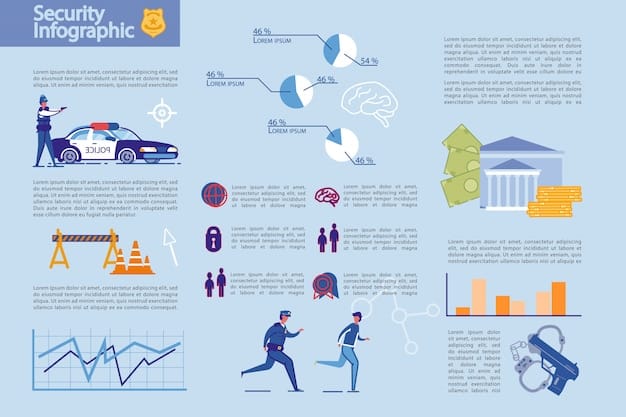How to Stay Informed About Local Crime: Your Guide to News & Data

Staying informed about local crime involves leveraging reliable news sources and data platforms to understand trends, ensuring community safety, and holding authorities accountable through informed civic engagement.
Staying informed about what’s happening in your neighborhood is crucial for personal safety and community well-being. But with so much information available, **how to stay informed about local crime: a guide to reliable news sources and data platforms** can help you navigate the options and find credible information.
Understanding the Importance of Local Crime Awareness
Being aware of local crime trends and incidents empowers residents to take proactive safety measures, participate in community initiatives, and advocate for effective law enforcement. Access to accurate and timely information is key to fostering a sense of security and collective responsibility.
Personal Safety and Preparedness
Knowing the types of crimes prevalent in your area helps you adjust your behaviors and security measures. For example, if burglaries are common, reinforcing your home security systems becomes a priority. Understanding local crime patterns enables informed decisions to protect yourself and your property.
Community Engagement and Advocacy
Informed citizens are better equipped to engage with local government and law enforcement. Participating in town hall meetings, neighborhood watch programs, and online forums allows you to voice concerns, propose solutions, and contribute to community safety initiatives.

Holding Authorities Accountable
Access to crime data allows you to evaluate the performance of local law enforcement. By comparing crime rates, clearance rates, and response times, you can hold authorities accountable for their actions and advocate for improved strategies and resource allocation.
Staying informed about local crime is beneficial for your personal safety and the well-being of the community, thus promoting active participation and accountability.
Traditional News Sources for Local Crime Information
Traditional news outlets, including newspapers, TV news, and radio stations, play a vital role in reporting local crime. These sources offer in-depth coverage and investigative journalism, providing context and analysis that may not be available elsewhere.
Local Newspapers: Depth and Context
Local newspapers typically offer comprehensive reporting on crime, including details about specific incidents, arrests, and court proceedings. They often conduct investigative pieces that delve deeper into underlying issues and systemic problems.
TV News: Visual and Immediate
TV news stations provide visual coverage of crime events, often featuring interviews with victims, witnesses, and law enforcement officials. Their immediacy can be particularly valuable during breaking news situations and ongoing investigations.
Radio: Real-Time Updates and Community Reporting
While perhaps not as comprehensive as newspapers or TV, local radio stations often provide real-time updates on crime incidents and community-related news. Radio can be especially useful in rural areas or during emergencies when other communication channels are disrupted.
- Benefits of Traditional News: In-depth reporting, investigative journalism, visual context, and real-time updates.
- Drawbacks: Can be sensationalized, may focus disproportionately on certain types of crime, and might not always be accessible without a subscription.
- Tips for Evaluating Credibility: Look for sources with a reputation for accuracy, check for corroborating evidence, and be wary of bias or sensationalism.
Traditional news sources provide extensive coverage of local crime events. However, it’s essential to evaluate credibility and be aware of potential bias.
Leveraging Online News Platforms and Websites
Online news platforms and websites offer immediate and widespread access to local crime information. These digital sources provide a variety of formats, including articles, videos, and interactive maps, enhancing your understanding of crime trends in your area.
Local News Websites: Up-to-date Information
Local news websites provide up-to-date coverage of crime events, often updating their content in real-time. These sites include articles, videos, and interactive maps, giving a comprehensive view of local crime trends.
Crime Mapping Websites and Apps: Visualizing Crime Data
Crime mapping websites and apps aggregate crime data from various sources and display it on maps, making it easy to visualize crime patterns and identify hotspots. These tools allow you to filter data by crime type, date range, and location.

Social Media and Community Forums: Local Insights
Social media platforms like Facebook, Twitter, and Nextdoor provide informal channels for sharing local crime information and insights. Community forums and neighborhood groups can offer direct updates from residents on local crime incidents.
- Benefits of Online Platforms: Accessibility, immediacy, visual data, and community insights.
- Drawbacks: Misinformation, lack of context, and potential privacy concerns.
- Tips for Verifying Information: Cross-reference information with multiple sources, be skeptical of anonymous posts, and report false or misleading content.
Online news platforms offer timely and widespread information but require careful verification to ensure accuracy and avoid misinformation.
Understanding and Using Government Data Platforms
Government data platforms provide access to official crime statistics and reports, offering valuable insights into local crime trends. Transparency in government data is vital for community awareness, accountability, and safety. Utilizing these platforms effectively involves understanding data collection and analysis methods.
Accessing Official Crime Statistics
Government data platforms, such as the FBI’s Uniform Crime Reporting (UCR) program and local police department websites, offer detailed crime statistics. These statistics include data on various crime types, arrest rates, and clearance rates, providing a comprehensive overview of crime trends in your area.
Utilizing Local Police Department Websites
Local police department websites feature crime maps, press releases, and community resources. Many departments also offer online tools for reporting crimes, filing complaints, and accessing safety tips. Staying connected with local police helps you remain informed about crime-related issues and initiatives.
Interpreting Crime Data Accurately
Interpreting crime data requires careful attention to context and methodology. Consider factors like reporting rates, population densities, and socioeconomic conditions when analyzing crime statistics. Misinterpreting crime data can lead to inaccurate conclusions and misdirected efforts.
Using the platform needs understanding to interpret crime data accurately for community insight.
Community Watch Programs and Neighborhood Associations
Community watch programs and neighborhood associations foster proactive community involvement in crime prevention. These grassroots initiatives provide opportunities for residents to collaborate with each other and with local law enforcement, enhancing community safety and awareness.
Joining a Neighborhood Watch Group
Neighborhood watch groups involve residents working together to monitor their neighborhoods, report suspicious activity, and promote safety. Joining a local watch group allows you to connect with your neighbors, share information, and participate in crime prevention efforts.
Participating in Local Associations
Local associations organize community events, advocate for improvements in the neighborhood, and serve as a liaison between residents and local government. Participating in these associations provides a platform for voicing concerns, proposing solutions, and contributing to community development.
Enhancing Community Safety Through Collaboration
Community safety needs collaboration between residents, law enforcement, and local government. By working together, communities can address crime at its roots, implement effective prevention strategies, and create a safer, more welcoming environment for everyone.
To prevent crime with collaboration and awareness one must join community initiatives and groups.
Educating Yourself on Crime Prevention Strategies
Educating yourself on crime prevention strategies is essential for protecting yourself and your community. By learning about common crime tactics, effective security measures, and responsible reporting practices, you can proactively reduce your risk of becoming a victim and contribute to a safer environment.
Implementing Home Security Measures
Implementing home security measures, such as installing reliable locks, reinforcing doors and windows, and setting up security systems, deters burglars and enhances your home’s physical security. Consider incorporating smart home devices, like security cameras and motion sensors, for added protection.
Practicing Personal Safety Tips
Practicing personal safety tips, such as being aware of your surroundings, avoiding walking alone at night, and protecting your personal information, lowers your risk of being targeted by criminals. Take extra precautions when traveling to unfamiliar areas or attending crowded events.
Reporting Suspicious Activity
Promptly reporting suspicious activity to local law enforcement increases the likelihood of detection and prevention. Trust your instincts and report anything that seems out of place or suspicious, even if you’re unsure if it’s a crime. Provide as much detail as possible when reporting incidents.
Proactive crime prevention strategies and reporting can create safer communities. To stay informed you must learn the latest crime prevention tactics.
| Key Point | Brief Description |
|---|---|
| 📰 News Sources | Stay updated with reliable local news (newspapers, TV, radio) and online platforms. |
| 📊 Data Platforms | Use government data and crime mapping websites for crime statistics. |
| 🤝 Community Groups | Join neighborhood watch programs and local associations. |
| 🛡️ Prevention | Enhance home security and follow safety tips to reduce personal risk. |
Frequently Asked Questions
▼
Reliable sources often include local newspapers, TV news stations, and government data platforms. Online news websites affiliated with established media outlets can also be useful.
▼
Cross-reference the information with multiple sources, especially official government websites or police department reports. Be skeptical of anonymous social media posts.
▼
A crime mapping website is an online tool that aggregates crime data and displays it on a map. It helps you visualize patterns and identify crime hotspots in your area.
▼
Contact your local police department or community association to inquire about neighborhood watch programs in your area. These groups often hold regular meetings and training sessions.
▼
Enhance home security with sturdy locks and security systems. Practice awareness of your surroundings, avoid walking alone at night, and protect personal information online.
Conclusion
Staying informed about local crime is crucial for personal safety and community well-being. By leveraging reliable news sources, government data platforms, community initiatives, and personal safety strategies, you can enhance awareness, promote accountability, and contribute to a safer environment for yourself and your neighbors.





